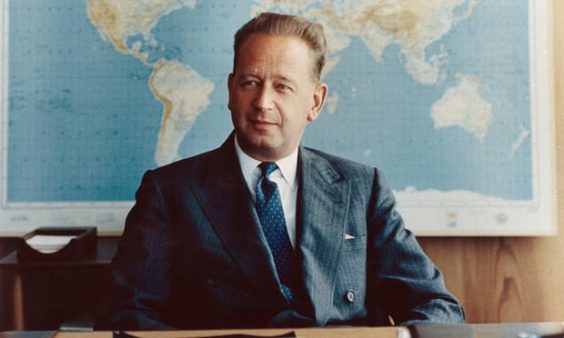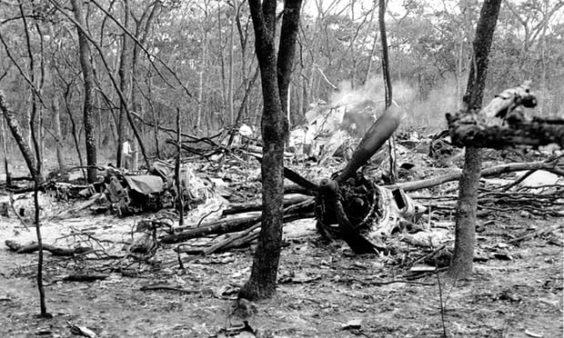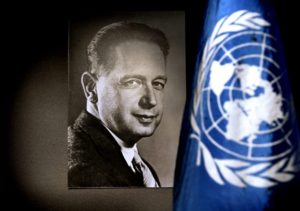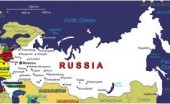Re Ian Bremmer 'Could third-party candidates upend the 2024 US election?' 3 April The current political movement in the USA…
Dag Hammarskjöld
Written by Diana Thebaud Nicholson // June 27, 2019 // United Nations // Comments Off on Dag Hammarskjöld
The Hammarskjöld Commission
Who Killed Hammarskjold?,” By Susan Williams
Cold Case Hammarskjöld – Official Trailer
United Nations Association Westminster (UK) Branch
The Guardian: Dag Hammarskjöld
(Wikipedia) Cold Case Hammarskjöld is a documentary film by Danish film maker Mads Brügger about the death of UN General Secretary Dag Hammarskjöld, whose airplane crashed in Northern Rhodesia (now Zambia) in 1961.
According to the film, Hammarskjöld’s plane was shot down by Belgian-British mercenary pilot Jan van Risseghem. Up to 2019, no culprit was known, and van Risseghem had referred to his plane’s log book, which indicated that he was not in Katanga at the time. However, pilot Roger Bracco told the filmmakers that the log was falsified. Another person who knew van Risseghem, Pierre Coppens, told the filmmakers that in 1965 van Risseghem had told him that he was the one who shot down the plane. van Risseghem had told him how he had solved the technical challenges in downing the plane. According to Coppens, van Risseghem did not know who was on board the plane when he shot it down.
The film Cold Case Hammarskjöld premiered on 26 January at the 2019 Sundance Film Festival.
27 June
‘Cold Case Hammarskjöld’ Trailer Reveals the Critically Acclaimed, Shocking Documentary
Magnolia Pictures has released the first trailer for the critically acclaimed documentary Cold Case Hammarskjöld, which remains one of the best-reviewed films of the year following its debut at the Sundance Film Festival in January. The film is hailed as a shocking, revelatory murder mystery as director/journalist Mads Brügger attempts to discover the truth behind the 1961 plane crash that killed United Nations secretary-general Dag Hammarskjöld. The crash has long been deemed an assassination given that Hammarskjöld was at the time advocating for Congo’s independence, but Brügger’s investigation offers up new and monumental revelations.
Check out the Cold Case Hammarskjöld trailer. The film will be released in theaters on August 16th
8 June
Was apartheid regime involved in UN chief’s death and African Aids plot?
The 58-year old mystery of why the plane went down is still under investigation, with many believing the South African apartheid government was involved.
Last December, a UN investigator looking into new evidence, criticised the UK and South Africa for their lack of cooperation.
Meanwhile, a new documentary has been released probing the apartheid regime’s reported involvement in Hammarskjöld’s death.
It also makes startling claims about a South African organisation allegedly involved in a global plot to spread Aids on the continent.
28 January
Sundance Film Review: ‘Cold Case Hammarskjöld’
Mads Brügger’s investigation of the death of Dag Hammarskjöld is a documentary that opens into a looking glass: a conspiracy that chills you.
(Variety) Directed by the Danish filmmaker Mads Brügger, it starts out as an offbeat journalistic inquiry into the 1961 plane-crash death of Dag Hammarskjöld, the secretary-general of the United Nations. Reviving old claims that have dogged the case but have never been proved, the film suggests that the crash was, in fact, engineered — that Hammarskjöld was murdered.
… Brügger presents an extensive interview with Alexander Jones, a former SAIMR militia member who makes the shocking claims that “Cold Case” leaves us with. And what was haunting when I first saw the film, and remains haunting, is the intent that Brügger captures. This is what a contingent of people in South Africa, allied with the government, at least wanted to do. And that’s eminently believable. And it chills us. “Cold Case Hammarskjöld” doesn’t offer the last word about the issues it raises. But it’s a movie that should be seen, grappled with, argued with, and experienced, because the questions it plants in us are dark enough to reverberate as powerfully as answers.
Quest to Solve Assassination Mystery Revives an AIDS Conspiracy Theory
12 January
Man accused of shooting down UN chief: ‘Sometimes you have to do things you don’t want to…’
Exclusive research reveals that a British-trained Belgian mercenary admitted the killing of Dag Hammarskjöld in 1961
RAF veteran ‘admitted 1961 killing of UN secretary general’
(The Guardian) Fifteen people on board died immediately, and the only survivor in hospital a few days later. The same day, a US ambassador sent a secret cable – one that stayed buried in files for decades – speculating about possible sabotage and apparently naming Van Risseghem as a suspect. …
Rumours about why the plane came down were fuelled by no less a figure than former US president Harry Truman. He told reporters two days after Hammarskjöld’s death that the UN leader “was on the point of getting something done when they killed him. Notice that I said ‘when they killed him.’”
He refused to elaborate, but it was the start of decades of suspicions that western governments were not sharing all the information they held about the crash.
Separate inquiries – including one by the UN, and another by Hammarskjöld’s native Sweden – failed to provide a compelling explanation of what happened, all blaming pilot error or reaching an open verdict.
It took nearly 50 years, and publication of a damning book by academic Susan Williams, Who Killed Hammarskjöld?, for the UN to start asking that same question again, rekindling doubts about the attack from conspiracy theorists who had picked over it for decades.
Among the critical evidence gathered by Williams and independent researcher Göran Björkdahl is testimony from a former US spy, posted to a listening station in Cyprus, who heard a recording of a pilot apparently narrating the attack as it unfolded, transmitted just minutes after it happened.
It matches accounts collected from Zambian witnesses living around the crash site, who said they had seen a second aircraft near Hammarskjöld’s plane and unusual lights and sounds in the sky. They had been largely ignored by white officials working on the early inquiries. The sole immediate survivor of the crash also described some kind of aerial attack, involving “sparks in the air” before he died a week after the crash. Doctors said he was lucid at the time, but his testimony had also been largely ignored. …
Pierre Coppens, who got to know Van Risseghem four years later when he was back in Belgium flying for a parachute training centre, said his friend told him those unspecified wider tasks also included attacking Hammarskjöld. He said he was simply ordered to bring down a plane and didn’t know who was inside, Coppens told researchers working on a new film about the crash, Cold Case Hammarskjöld. It premieres at the Sundance film festival in two weeks’ time, and names Van Risseghem as the attacker. Full details of the filmmakers’ research are revealed here for the first time.
RAF veteran ‘admitted 1961 killing of UN secretary general’
Exclusive: Cold case documentary casts new light on mystery of Dag Hammarskjöld’s plane crash
New evidence has emerged linking an RAF veteran to the death in 1961 of the UN secretary general Dag Hammarskjöld in a mysterious plane crash in southern Africa.
Jan van Risseghem has been named as a possible attacker before, but has always been described simply as a Belgian pilot. The Observer can now reveal that he had extensive ties to Britain, including a British mother and wife, trained with the RAF and was decorated by Britain for his service in the second world war.
Film-makers investigating the 1961 crash for a documentary, Cold Case Hammarskjöld, have found a friend of Van Risseghem who claimed the pilot confessed to shooting down the UN plane. They also gathered testimony from another pilot that undermines one of his alibis for that night.
… by 1961 Van Risseghem was in the Congo, flying for separatist rebels who had declared independence for the breakaway province of Katanga. There, the documentary claims, he was ordered to shoot down a plane carrying Hammarskjöld, who was on a secret midnight journey to try to broker peace. The film will premiere at the Sundance festival in two weeks.
It was not clear at the time of the crash, which also killed all 15 people travelling with the secretary general, if it had been caused by sabotage or was a tragic accident. More than half a century later the UN is still investigating what happened on 18 September 1961. But as news of Hammarskjöld’s death emerged, the RAF veteran was apparently an obvious suspect. He was named as the possible attacker by the US ambassador to the Congo, in a secret cable sent the day of Hammarskjöld’s death and only recently declassified.
 Dag Hammarskjöld was on a mission to try to broker peace in Congo when he died in 1961. Photograph: REX
Dag Hammarskjöld was on a mission to try to broker peace in Congo when he died in 1961. Photograph: REX
2018
12 December
Dag Hammarskjöld crash inquiry: UK and South Africa criticised for not cooperating
UN investigator says six states approached complied, but UK and South Africa unhelpful
In a progress report on his investigation, Mohamed Chande Othman said fresh information had surfaced in the past year that could cast light on the crash”
In his [progress] report (pdf), the judge said the UK and South Africa had been entirely unhelpful. Both governments ignored a UN general assembly resolution calling for the appointment of “an independent and high-ranking official to conduct a dedicated internal review of their intelligence, security and defence archives” for relevant information.”
The judge, who is due to complete his inquiry in 2019, rejected that argument, saying it was “almost certain” the UK still had undisclosed information of “probative value”.
1 June 2018
Judge Reports Progress in Hammarskjold Crash Inquiry
(NYT) A prominent jurist conducting an investigation into the plane crash that killed United Nations Secretary General Dag Hammarskjold 57 years ago has made some progress in a longstanding quest for access to secret intelligence archives, a group following the inquiry said Friday.
In addition the jurist, Mohamed Chande Othman, a former chief justice of Tanzania, may widen the net to other countries and may seek clues in corporate archives from the era, said the group, the United Nations Association Westminster Branch.
Mr. Othman was reauthorized in March by the current secretary general, António Guterres, to establish whether the plane crash near Ndola, Northern Rhodesia — now Zambia — was caused by “an external attack or threat,” in the words of an earlier report.
27 March 2018
Secretary-General Reappoints Mohamed Chande Othman of United Republic of Tanzania to Continue Work in Dag Hammarskjöld Investigation
United Nations Secretary-General António Guterres is pleased to confirm that, pursuant to General Assembly resolution 72/252, he has reappointed Mohamed Chande Othman, former Chief Justice of the United Republic of Tanzania, to continue his work in relation to the investigation into the tragic death of Dag Hammarskjöld and of the members of the party accompanying him.
It is recalled that the Secretary-General had previously appointed Chief Justice Othman as Eminent Person pursuant to General Assembly resolution 71/260, and the Secretary-General transmitted the Eminent Person’s report to the General Assembly in September 2017 (document A/71/1042). That report concluded, among other things, that it remained plausible that an external attack or threat may have been a cause of the crash.
The Secretary-General urges Member States to actively assist the Eminent Person in the performance of his mandate. In this respect, and as provided for in General Assembly resolution 72/252, the Secretary-General calls on Member States that may hold information relevant to the Dag Hammarskjöld investigation to appoint an independent and high-ranking official to conduct a dedicated internal review of their intelligence, security and defence archives to determine whether relevant information exists.
The Secretary-General renews his commitment to this matter in the strongest terms as he firmly believes that he owes it to his illustrious and distinguished predecessor, Dag Hammarskjöld, and to the other members of the party accompanying him and to their families, to pursue the full truth of this matter.
2017
26 September 2017
Plane crash that killed UN boss ‘may have been caused by aircraft attack’
Exclusive: US and UK intercepts could hold answer to 1961 accident in Africa that killed Dag Hammarskjöld and 15 others
(The Guardian) A UN report into the death of its former secretary general Dag Hammarskjöld in a 1961 plane crash in central Africa has found that there is a “significant amount of evidence” that his flight was brought down by another aircraft.
The report, delivered to the current secretary general, António Guterres, last month, took into account previously undisclosed information provided by the US, UK, Belgian, Canadian and German governments.
Its author, Mohamed Chande Othman, a former Tanzanian chief justice, found that the US and UK governments had intercepted radio traffic in the area at the time and suggested that the 56-year-old mystery could be solved if the contents of those classified recordings were produced.
“I am indebted for the assistance that I received, which uncovered a large amount of valuable new information,” Othman said in an executive summary of his report, seen by the Guardian. “I can confidently state that the deeper we have gone into the searches, the more relevant information has been found.”
Hammarskjöld, a Swedish diplomat who became the UN secretary general in 1953, was on a mission in September 1961 to try to broker peace in Congo, where the Katanga region had staged a rebellion, backed by mining interests and European mercenaries, against the newly independent government in Kinshasa.
His plane, a Douglas DC-6, was on the way from Kinshasa to the town of Ndola in Northern Rhodesia (now Zambia), where the British colonial authorities were due to host talks with the Katanga rebels. It was approaching the airstrip at about midnight on 17 September when it crashed, killing Hammarskjöld and 15 others on board.
Two inquiries run by the British pointed to pilot error as the cause, while a UN commission in 1962 reached an open verdict. In recent years, independent research by Göran Björkdahl, a Swedish aid worker, and Susan Williams, a senior fellow at the Institute of Commonwealth Studies in London and author of a 2011 book Who Killed Hammarskjöld?, persuaded the UN to reopen the case. A panel convened in 2015 found there was enough new material to warrant the appointment of an “eminent person” to assess it. Othman was given the job in February this year.
Among Othman’s new findings are:
- In February 1961, the French secretly supplied three Fouga warplanes to the Katanga rebels, “against the objections of the US government”. Contrary to previous findings, they were used in air-to-air attacks, flown at night and from unpaved airstrips in Katanga.
- Fresh evidence bolsters an account by a French diplomat, Claude de Kemoularia, that he had been told in 1967 by a Belgian pilot known as Beukels, who had been flying for the rebels as a mercenary, that he had fired warning shots to try to divert the plane away from Ndola and accidentally clipped its wing. Othman said he was unable establish Beukels’ identity in the time available for his inquiry.
- The UK and Rhodesian authorities were intercepting UN communications at the time of the crash and had intelligence operatives in the area. The UK should therefore have potentially crucial evidence in its classified archives
- The US had sophisticated electronic surveillance aircraft “in and around Ndola” as well as spies, and defence officials, on the night of the crash, and Washington should be able to provide more detailed information.
Othman found that earlier inquiries had disregarded the testimony of local witnesses who said they saw another plane and flashes in the sky on the night of Hammarskjold’s crash. They had also “undervalued” the testimony of Harold Julien, a security officer who survived for several days who told medical staff he had seen “sparks in the sky” shortly before the DC-6, known by its registration number SE-BDY, fell out of the sky.
“Based on the totality of the information we have at hand, it appears plausible that external attack or threat may have been a cause of the crash, whether by way of direct attack causing SE-BDY to crash, or by causing a momentary distraction of the pilots,” Othman concludes.
“There is a significant amount of evidence from eyewitnesses that they observed more than one aircraft in the air, that the other aircraft may have been a jet, that SE-BDY was on fire before it crashed, and/or that SE-BDY was fired upon or otherwise actively engaged by another aircraft. In its totality, this evidence is not easily dismissed.”
Othman argues that the “burden of proof” was now on member states “to show that they have conducted a full review of records and archives in their custody or possession, including those that remain classified, for potentially relevant information”.
The Tanzanian judge said that the most relevant pieces of information were radio intercepts and called for countries likely to have relevant information, such as the UK and US, to appoint an “independent and high-ranking official” to comb the archives.
“Any such information regarding what occurred during the last minutes of SE-BDY, if verifiable, will be likely to either prove or disprove one or more of the existing hypotheses, bringing us more proximate to closure,” Othman writes.
“This is a step that must be taken before this matter, and the memories of those who perished on flight SE-BDY in the service of the organisation, may rest.”
15 July 2017
Do Spy Agencies Hold Answer to Dag Hammarskjold’s Death? U.N. Wants to Know.
After 56 years and many investigations, there is new hope that secrets lurking in Western intelligence archives could solve the biggest whodunit in United Nations history: the mysterious death of Secretary General Dag Hammarskjold.
Whether the keepers of those archives will allow access remains an open question.
Mr. Hammarskjold, an iconic Swedish diplomat who was the second secretary general of the world body, died with 15 others when their plane, a chartered DC-6, crashed just after midnight on Sept. 18, 1961, minutes from its destination: an airfield in Ndola, in what was then the British protectorate of Northern Rhodesia and is now Zambia.
The three official inquiries that immediately followed suggested pilot error was the cause, but the third of the reports, by the United Nations Commission of Investigation in 1962, said sabotage could not be ruled out. That possibility helped feed suspicions and conspiracy theories that Mr. Hammarskjold, 56 at the time of his death, had been assassinated.
Independent investigators and academics have spent years collecting and scrutinizing evidence that had been dismissed or suppressed, bolstering the theory of foul play. In her 2011 book “Who Killed Hammarskjold?,” Susan Williams, a University of London scholar of African decolonization, concluded that “whatever the details, his death was almost certainly the result of a sinister intervention.”
2016
 The wreckage of the plane after the crash in which Dag Hammarskjöld died near Ndola, Zambia, in 1961. Photograph: AP
The wreckage of the plane after the crash in which Dag Hammarskjöld died near Ndola, Zambia, in 1961. Photograph: AP
3 December
UN to pursue further inquiry into death of Dag Hammarskjöld
General Assembly to pass resolution recognising need to investigate death of former general secretary who died in 1961 plane crash
Few who have studied the crash will be confident that anyone can ever know what really happened. But a plausible theory is starting to emerge.
A report from a panel of distinguished international jurists, commissioned by the Hammarskjöld Inquiry Trust chaired by Lord Lea of Crondall and submitted to the UN last year, heard suggestions “that a group representing a number of European political and business interests … wanted the secretary general’s plane diverted from Ndola [city in Zambia] … in order to persuade him of the case for Katanga’s continued independence”.
The group feared what would happen to their mining concessions if Katanga was reabsorbed into Soviet-backed Congo.
2 September
Letter to The Guardian
Richard J Goldstone: Hammarskjöld case is not yet closed
The 2013 report of an independent international commission of jurists, of which I was a member, concluded that, pilot error, though unproven, was the default explanation of the 1961 crash at Ndola in which Dag Hammarskjöld died. However, there was at least one other well-supported explanation, namely that the UN chartered airliner had been fired on by a jet fighter – probably a Katangan plane piloted by a Belgian or South African mercenary – as it came in over the forest to land.
28 August
Letters to The Guardian
UK’s lack of transparency over plane crash that killed Dag Hammarskjöld
25 August
Dag Hammarskjöld: Ban Ki-moon seeks to appoint investigator for fatal crash
The UN secretary-general said ‘this may be our last chance to find the truth’ behind 1961 death of his predecessor as UK insists it has no further information
2015

Dag Hammarskjölds museum i Backåkra på Österlen. Han var FN:s generalsekreterare från 1953 tills han omkom i en flygkrasch i Zambia 1961.
TMS: Dag Hammarskjold (29 Jul 1905 – 18 Sep 1961): Crisis Manager and Longer-Range World Community Builder
Rene Wadlow – TRANSCEND Media Service
Hammarskjold came to the United Nations just as socio-economic development was being considered as a permanent mandate for the UN Secretariat. At the time of the creation of the United Nations in 1945, economic and social issues were considered as the functions of specialized agencies formally related to the UN through the Economic and Social Council but in effect, independent with their own governing boards, budgets and administrative procedures: the World Bank and the International Monetary Fund in Washington, and UNESCO, FAO, ILO, WHO, all located in Europe. By 1949, influenced by the “Point Four” idea of US President Harry Truman, there started to grow the idea that the UN itself should become operative in providing economic, administrative, and technical assistance. A modest “Expanded Program of Technical Assistance to Underdeveloped Countries” was created in 1949, and through different incarnations has become the UN Development Program (UNDP)’s, complex and multi layered activities.
Hammarskjold was a strong supporter of economic and social programs. He appointed well-known and active economists to guide these programs. By training and temperament, he would have wanted to follow economic and social issues as he saw such programs as important building-blocs of the world community.
However, it was as a crisis manager that he filled his days. These were often long days, and he was able to work for 18 hours a day for long stretches of time. He started as Secretary-General when the war in Korea was ending, but peace had not been established. Korea was still divided into two hostile States, a large number of people had been uprooted and much of the economic infrastructure destroyed. The French war in Indochina was still going on, and many observers feared that there could be a generalized Asian conflict. In 1952, the UN General Assembly created the “Commission on the Racial Situation in South Africa” – the start of a decades-long concern. The French war in Indochina was followed by the start of the war in Algeria. In April 1955, the “Asian-Africa Conference” was held in Bandung, Indonesia, a sign that decolonization would stay on the agenda of world issues for a long time. In November 1956, the first session of a UN Special General Assembly condemned the military aggression of the UK, France and Israel against Egypt, which later led to the use of UN Peacekeeping forces.
2014
4 April
Dag Hammarskjöld’s plane may have been shot down, ambassador warned
Newly declassified 1961 cable called for grounding of Belgian mercenary hours after UN secretary general crashed in Africa
(The Guardian) Hours after a plane carrying the UN secretary general, Dag Hammarskjöld, crashed over central Africa in September 1961, the US ambassador to Congo sent a cable to Washington claiming that the aircraft could have been shot down by a Belgian mercenary pilot.
In the newly declassified document, the ambassador, Ed Gullion, does not directly implicate the Belgian or Rhodesian governments in what he calls “this operation”, but calls for US pressure on them to ground the mercenary, adding it was “obviously [a] matter of highest importance”. He said the pilot had been hampering UN operations and warned that if not stopped “he may paralyse air-rescue operations”.
The document was released after an international panel of retired judges called last year for a fresh inquiry into the Hammarskjöld crash, saying that new evidence “undoubtedly” existed. The UN secretary general, Ban Ki-moon, decided in February to put the panel’s findings on the agenda of the UN general assembly.
The Gullion cable was not seen by previous official inquiries. A commission formed by the Rhodesian colonial authorities blamed the crash on pilot error, while a later UN investigation recorded an open verdict.
A Guardian investigation in 2011 found surviving witnesses near the crash site outside Ndola, in what is now Zambia, saying they saw a second plane shooting at the DC-6 aeroplane carrying Hammarskjöld and his aides. A book published later that year, Who Killed Hammarskjöld? by Susan Williams, a University of London researcher, found further evidence of foul play.
Williams’s book pointed to the existence of US National Security Agency (NSA) radio intercepts of warplanes in the area, which are still top secret after 52 years. Hammarskjöld’s death came at the height of a conflict between the UN-backed Congolese government in Leopoldville, now Kinshasa, and secessionists from the mineral-rich province of Katanga, supported by Belgian colonialists.
The US and British were angry at an abortive UN military operation that the secretary general had ordered days before his death on behalf of the Congolese government against the rebellion in Katanga, which was backed by western mining companies and mercenaries.
The Hammarskjöld commission, chaired by a former British court of appeal judge, Sir Stephen Sedley, called for the NSA intercepts to be released.
The commission highlighted several key pieces of evidence, including the testimony of two policemen of seeing sparks and a flash in the sky, and the account of a local official who said he saw a smaller aeroplane flying above and then alongside the DC-6, known as the Albertina.
In his cable, sent at 11am on 18 September, Gullion correctly identifies the Ndola area as the crash site. He also names the suspected Belgian pilot as “Vak Riesseghel”, almost certainly a mis-spelling of Jan van Risseghem, who had served in the South African and Rhodesian air forces, and commanded the small Katanga air force.
In another cable sent two days before the crash, Gullion passed on a commercial pilot’s report that the Belgian mercenary, flying a Katangese jet, “flew wing to wing” with him – a highly dangerous manoeuvre.
Gullion’s two telegrams call into question Van Risseghem’s insistence that he had not been in Katanga in September 1961. Van Risseghem was never questioned by any of the official inquiries.
“The telegram reveals that on the morning after the crash, the ambassador thought it credible that the plane had been shot down by a mercenary pilot – so credible, in fact, as to justify asking US diplomats in Brussels and Salisbury [now Harare] to put pressure on the Belgian and Rhodesian governments to ground the pilot,” said Williams, a senior researcher at the University of London’s Institute of Commonwealth Studies.
In her book, Williams provides the account of an American naval pilot, Commander Charles Southall, who was working at the NSA listening station in Cyprus in 1961. Shortly after midnight on the night of the crash, Southall and other officers heard an intercept of a pilot’s commentary in the air over Ndola – 3,000 miles away.
Southall recalled the pilot saying: “I see a transport plane coming low. All the lights are on. I’m going down to make a run on it. Yes, it is the Transair DC-6. It’s the plane,” adding that his voice was “cool and professional”. Then he heard the sound of gunfire and the pilot exclaiming: “I’ve hit it. There are flames! It’s going down. It’s crashing!”
Williams said: “We need to know if the US state department holds the raw intelligence that led Gullion to think [the plane could have been shot down] and … if there is other intelligence, notably in the form of intercepts, that is held by the NSA in relation to Hammarskjöld’s flight on the night of 17-18 September 1961.
“This newly released document reinforces the argument that the UN general assembly should ask US agencies, including the NSA, to produce the evidence they hold.”
2013
9 September
Judges call for reopening of inquiry into 1961 death of UN chief
Commission appeals to US to declassify NSA radio intercepts of warplanes in area where Dag Hammarskjöld’s plane crashed
2011
17 August 2011
Dag Hammarskjöld: evidence suggests UN chief’s plane was shot down
Eyewitnesses claim a second aircraft fired at the plane raising questions of British cover-up over the 1961 crash and its causes
New evidence has emerged in one of the most enduring mysteries of United Nations and African history, suggesting that the plane carrying the UN secretary general Dag Hammarskjöld was shot down over Northern Rhodesia (now Zambia) 50 years ago, and the murder was covered up by British colonial authorities.
A British-run commission of inquiry blamed the crash in 1961 on pilot error and a later UN investigation largely rubber-stamped its findings. They ignored or downplayed witness testimony of villagers near the crash site which suggested foul play. The Guardian has talked to surviving witnesses who were never questioned by the official investigations and were too scared to come forward.
… key witnesses were located and interviewed over the past three years by Göran Björkdahl, a Swedish aid worker based in Africa, who made the investigation of the Hammarskjöld mystery a personal quest since discovering his father had a fragment of the crashed DC6.
Hammarskjöld was flying to Ndola for peace talks with the Katanga leadership at a meeting that the British helped arrange. The fiercely independent Swedish diplomat had, by then, enraged almost all the major powers on the security council with his support for decolonisation, but support from developing countries meant his re-election as secretary general would have been virtually guaranteed at the general assembly vote due the following year.
The witness accounts of another plane are consistent with other insider accounts of Hammarskjold’s death. Two of his top aides, Conor Cruise O’Brien and George Ivan Smith, both became convinced that the secretary general had been shot down by mercenaries working for European industrialists in Katanga. They also believed that the British helped cover up the shooting. In 1992, the two published a letter in the Guardian spelling out their theory. Suspicion of British intentions is a recurring theme of the correspondence Björkdahl has examined from the days before Hammarskjöld’s death.
Formally, the UK backed the UN mission, but, privately, the secretary general and his aides believed British officials were obstructing peace moves, possibly as a result of mining interests and sympathies with the white colonists on the Katanga side.



